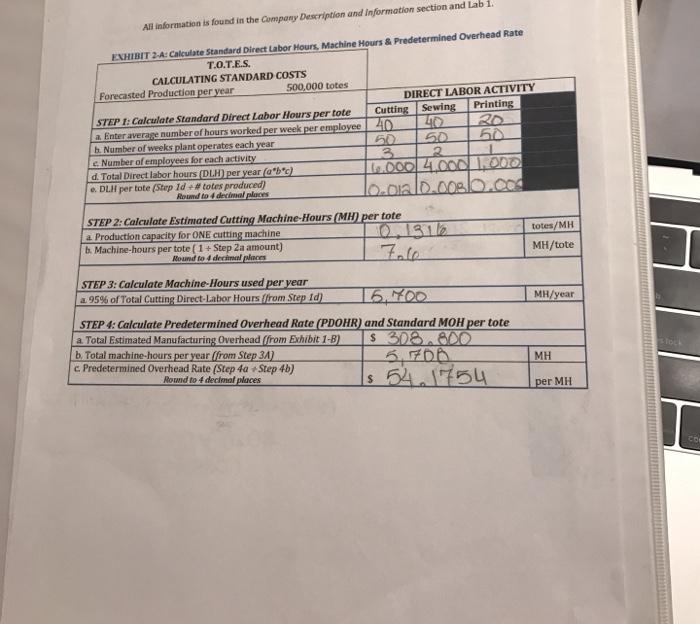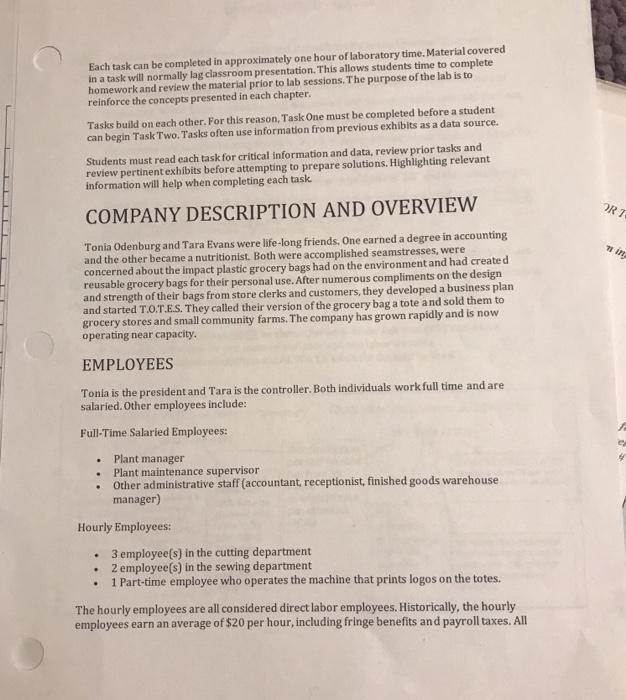i would just like to see if E. DLH per totes is correct and if not what did i do wrong. i have a feeling my numbers are off, thank you!

All information is found in the Company Description and Information section and Labi. EXHIBIT 2A: Calcutate Standard Direct Labor Hours, Machine Hours & Predetermined Overhead Rate T.O.T.E.S. CALCULATING STANDARD COSTS Forecasted Production per year 500,000 totes DIRECT LABOR ACTIVITY STEP 1: Calculate Standard Direct Labor Hours per tote Cutting Sewing Printing inter average number of hours worked per week per employee 240 402 Number of weeks plant operates each year 50 c. Number of employees for each activity 3 2. d. Total Direct labor hours (DLH) per year (a*b*s) 1.000 4.000 LODD e DLH per tote (Step 1d #totes produced Round to decimal places lo.dia 0.0080.00 STEP 2: Calculate Estimated Cutting Machine-Hours (MH) per tote a Production capacity for ONE cutting machine 0.131 b. Machine-hours per tote (1+Step 2a amount) Nound to 4 dechraces 7ale totes/MH MH/tote MH/year STEP 3: Calculate Machine-Hours used per year a 95% of Total Cutting Direct-Labor Hours from Step Id) 16.00 STEP 4: Calculate Predetermined Overhead Rate (PDOHR) and Standard MOH per tote a Total Estimated Manufacturing Overhead (from Exhibit 1-B) $ 308.800 b. Total machine hours per year from Step 34) c Predetermined Overhead Rate (Step 4a Step 4b) Round to 4 decimal places Is 54.1754 5,700 MH per MH Each task can be completed in approximately one hour of laboratory time. Material covered in a task will normally lag classroom presentation. This allows students time to complete homework and review the material prior to lab sessions. The purpose of the lab is to reinforce the concepts presented in each chapter. Tasks build on each other. For this reason, Task One must be completed before a student can begin Task Two. Tasks often use information from previous exhibits as a data source. Students must read each task for critical information and data, review prior tasks and review pertinent exhibits before attempting to prepare solutions. Highlighting relevant information will help when completing each task 2R1 COMPANY DESCRIPTION AND OVERVIEW win Tonia Odenburg and Tara Evans were life-long friends. One earned a degree in accounting and the other became a nutritionist. Both were accomplished seamstresses, were concerned about the impact plastic grocery bags had on the environment and had created reusable grocery bags for their personal use. After numerous compliments on the design and strength of their bags from store clerks and customers, they developed a business plan and started T.O.T.E.S. They called their version of the grocery bag a tote and sold them to grocery stores and small community farms. The company has grown rapidly and is now operating near capacity. EMPLOYEES Tonia is the president and Tara is the controller. Both individuals work full time and are salaried. Other employees include: Full-Time Salaried Employees: SO 4 . Plant manager Plant maintenance supervisor Other administrative staff (accountant receptionist, finished goods warehouse manager) Hourly Employees: 3 employee(s) in the cutting department 2 employee(s) in the sewing department 1 Part-time employee who operates the machine that prints logos on the totes. The hourly employees are all considered direct labor employees. Historically, the hourly employees earn an average of $20 per hour, including fringe benefits and payroll taxes. All tu Over hourly employees work 40 hours each week except for the part-time employee who works 20 hours each week MATERIALS Each grocery bag requires 1/4 yard of 60" wide fabric and 1-1/2 yards of webbing. The fabric costs $3.60 per yard. Webbing costs 50.76 per yard. Thread is purchased in 500-yard spools and is considered an indirect material. After the totes pass quality control they are silk-screened with a customer's logo and the T.O.T.E.S. label is attached. Both the logo ink and the company labels are Indirect materials MANUFACTURING OVERHEAD T.O.T.E.S. allocates manufacturing overhead using a plantwide overhead rate based on machine hours in the cutting department. The cutting machines operate 95% of the hours worked by the cutting department employees. The plant operates 50 weclos per year. INVENTORY T.O.T.E.S. operates on a just-in-time basis in regards to both raw materials and finished goods. Work-in-process inventory is negligible at the end of each month. The company has found that it needs to have 20% of the following month's production requirements on hand at the end of each month in order to meet sales projections. They plan to have 5% of the fabric and 10% of the webbing required for the following month's production on hand ut the end of each month, SALES FORECAST In the upcoming year, T.O.T.ES, management forecasted sales of 500,000 totes. Each tote sells for $4.95. Tara estimated annual revenue and expenses based on that level of sales and production. Her estimates are shown on Exhibit 1-A. COST CLASSIFICATIONS AND OPERATING BUDGET LAB 1 T.O.T.ES. is a manufacturing company and keeps close tabs on their costs in order to price their tote bags competitively and maintain profitability. Costs are assigned different classifications depending on the information needed for various managerial decisions. In All information is found in the Company Description and Information section and Labi. EXHIBIT 2A: Calcutate Standard Direct Labor Hours, Machine Hours & Predetermined Overhead Rate T.O.T.E.S. CALCULATING STANDARD COSTS Forecasted Production per year 500,000 totes DIRECT LABOR ACTIVITY STEP 1: Calculate Standard Direct Labor Hours per tote Cutting Sewing Printing inter average number of hours worked per week per employee 240 402 Number of weeks plant operates each year 50 c. Number of employees for each activity 3 2. d. Total Direct labor hours (DLH) per year (a*b*s) 1.000 4.000 LODD e DLH per tote (Step 1d #totes produced Round to decimal places lo.dia 0.0080.00 STEP 2: Calculate Estimated Cutting Machine-Hours (MH) per tote a Production capacity for ONE cutting machine 0.131 b. Machine-hours per tote (1+Step 2a amount) Nound to 4 dechraces 7ale totes/MH MH/tote MH/year STEP 3: Calculate Machine-Hours used per year a 95% of Total Cutting Direct-Labor Hours from Step Id) 16.00 STEP 4: Calculate Predetermined Overhead Rate (PDOHR) and Standard MOH per tote a Total Estimated Manufacturing Overhead (from Exhibit 1-B) $ 308.800 b. Total machine hours per year from Step 34) c Predetermined Overhead Rate (Step 4a Step 4b) Round to 4 decimal places Is 54.1754 5,700 MH per MH Each task can be completed in approximately one hour of laboratory time. Material covered in a task will normally lag classroom presentation. This allows students time to complete homework and review the material prior to lab sessions. The purpose of the lab is to reinforce the concepts presented in each chapter. Tasks build on each other. For this reason, Task One must be completed before a student can begin Task Two. Tasks often use information from previous exhibits as a data source. Students must read each task for critical information and data, review prior tasks and review pertinent exhibits before attempting to prepare solutions. Highlighting relevant information will help when completing each task 2R1 COMPANY DESCRIPTION AND OVERVIEW win Tonia Odenburg and Tara Evans were life-long friends. One earned a degree in accounting and the other became a nutritionist. Both were accomplished seamstresses, were concerned about the impact plastic grocery bags had on the environment and had created reusable grocery bags for their personal use. After numerous compliments on the design and strength of their bags from store clerks and customers, they developed a business plan and started T.O.T.E.S. They called their version of the grocery bag a tote and sold them to grocery stores and small community farms. The company has grown rapidly and is now operating near capacity. EMPLOYEES Tonia is the president and Tara is the controller. Both individuals work full time and are salaried. Other employees include: Full-Time Salaried Employees: SO 4 . Plant manager Plant maintenance supervisor Other administrative staff (accountant receptionist, finished goods warehouse manager) Hourly Employees: 3 employee(s) in the cutting department 2 employee(s) in the sewing department 1 Part-time employee who operates the machine that prints logos on the totes. The hourly employees are all considered direct labor employees. Historically, the hourly employees earn an average of $20 per hour, including fringe benefits and payroll taxes. All tu Over hourly employees work 40 hours each week except for the part-time employee who works 20 hours each week MATERIALS Each grocery bag requires 1/4 yard of 60" wide fabric and 1-1/2 yards of webbing. The fabric costs $3.60 per yard. Webbing costs 50.76 per yard. Thread is purchased in 500-yard spools and is considered an indirect material. After the totes pass quality control they are silk-screened with a customer's logo and the T.O.T.E.S. label is attached. Both the logo ink and the company labels are Indirect materials MANUFACTURING OVERHEAD T.O.T.E.S. allocates manufacturing overhead using a plantwide overhead rate based on machine hours in the cutting department. The cutting machines operate 95% of the hours worked by the cutting department employees. The plant operates 50 weclos per year. INVENTORY T.O.T.E.S. operates on a just-in-time basis in regards to both raw materials and finished goods. Work-in-process inventory is negligible at the end of each month. The company has found that it needs to have 20% of the following month's production requirements on hand at the end of each month in order to meet sales projections. They plan to have 5% of the fabric and 10% of the webbing required for the following month's production on hand ut the end of each month, SALES FORECAST In the upcoming year, T.O.T.ES, management forecasted sales of 500,000 totes. Each tote sells for $4.95. Tara estimated annual revenue and expenses based on that level of sales and production. Her estimates are shown on Exhibit 1-A. COST CLASSIFICATIONS AND OPERATING BUDGET LAB 1 T.O.T.ES. is a manufacturing company and keeps close tabs on their costs in order to price their tote bags competitively and maintain profitability. Costs are assigned different classifications depending on the information needed for various managerial decisions. In










